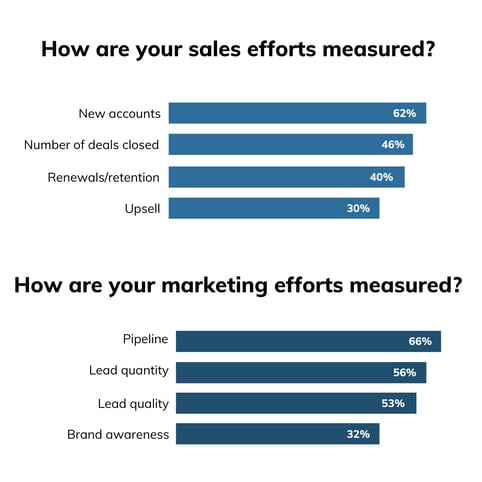 Sales and Marketing alignment. It's what makes ABM succeed or fail.
Sales and Marketing alignment. It's what makes ABM succeed or fail.
Without Sales and Marketing alignment, you’re rowing upriver, taking on water, carrying extra weight and definitely feeling that there must be an easier way to get from A to B.
While there is much talk of Sales and Marketing alignment, the unfortunate reality is that, depending on which study you read, at least 25% of Sales and Marketing teams continue to operate as independent, siloed departments.
Even those teams that do ‘claim’ alignment in reality are only partially aligned at best, with much work yet to do with only 17% of teams stating complete alignment.
Marketing continues, in a large part, to be responsible for brand, content, events, and campaigns that generate leads, etc. while Sales focuses on winning and growing accounts.
Make sure that you have that Marketing and Sales alignment because if you don't have that at the very beginning, you're never going to have it - Amy Hall, Global ABM Manager at Hitachi Vantara (Let’s Talk ABM: ABM From the Trenches)
This misalignment means the two departments don’t speak the same language - they see the world from two different viewpoints - and are measured (and measure themselves) in very different ways.
With numerous studies showing that failure to align Sales and Marketing teams costs B2B companies revenue slippage of anywhere up to 10%, it’s clearly time for Sales and Marketing to plot a new path and a new way of working.
Why is Sales and Marketing Alignment Key to Successful Account-based Marketing?
While there are many definitions of Account-based Marketing (ABM), our view is that its primary aim is to help you to win, grow, and retain your most valuable accounts.
ABM is therefore a strategic pivot, a business-wide initiative.
While Sales and Marketing are two key players in this pivot, it goes beyond them and includes many other departments - right up to the C-suite.
With the spotlight of the business more and more on Account-based Marketing, the question of alignment comes more and more into focus.
ABM is very much that unifier.
ABM’s focus is Accounts - the same language of Sales.
The good news is that ABM by its very nature brings the two teams together—as long as both Sales and Marketing can agree to work together. If you’re finding it challenging to get Sales to buy-in at first, you’re not alone. Ultimately, you are working toward a Sales and Marketing partnership but the first step is, of course, alignment - Marketo
So what happens if you can achieve Sales and Marketing alignment by following best practices? Here are some compelling numbers:
• 50% reduction in sales time wasted on unproductive prospecting
• 67% better at closing deals
• 32% higher revenue
• 38% higher win rates
With these compelling numbers to support Sales and Marketing alignment, let’s look at some key areas to focus on to help you achieve your goal.
1. Align your Ideal Customer Profile (ICP)
Who is your Ideal Customer?
What kind of customers do you want more of (and indeed fewer of)?
Unless Sales and Marketing can agree on this fundamental step there is little hope of sales and marketing alignment and very little hope of a successful ABM program.
We certainly see this in the projects we deliver to B2B tech companies across the globe.
40% - that’s the amount of Sales time spent on unproductive prospecting. With that incredible waste of time, effort and money, it is no longer a surprise why so many companies are looking to align Sales and Marketing teams behind the same group of prospects.
After all, we’ve all experienced organisations where Marketing delivers leads that Sales doesn’t want or know what to do with.
By deciding on the ICP together, both teams will have clarity surrounding who they are targeting, which will reduce friction further down the line, as both departments agree on which accounts are worth pursuing.
Ultimately, your ICP is going to shape the entire ABM initiative, so it’s imperative that you get it right!
2. Align your KPIs
One of the biggest differences often seen between Sales and Marketing is the way in which each team measures success.
While much progress has been made, there is still a sense that the two teams speak very different languages, with Sales focused on Accounts, Deals and Renewals while Marketing talks the language of Pipeline, Lead quantity and Lead quality.
One could argue hard numbers of Sales vs. soft numbers of Marketing.

Account-based Marketing changes all that.
The one language is the language of Accounts.
To unite behind this banner, the two teams need one set of metrics, one set of KPIs, one dashboard, one North Star...
ABM can’t be called ABM if Sales does not input into strategy - and that all starts with metrics.
As it currently stands, only 31.8% of sales reps and marketers align on analytics and metrics.
And as a result, there is likely to be misunderstanding and miscommunication with regards to what Sales and Marketing expect from one another and how well each thinks they are doing.
Focus on the numbers that really matter.
When the Sales and Marketing teams are looking at the same metrics and trying to hit the same North Star, lots of other pieces of ABM fall into place - Samantha Mayer, SMB and Pardot Growth Marketing, Salesforce Pardot
So what do these numbers look like?
Revenue is the one that we would all agree on.
A recent Forrester report also cited Customer Satisfaction and Customer Retention as the additional two metrics in the ‘Top 3’ most important metrics to track in an ABM program.
Not deal size, leads or conversion rates…
Sit down together with your colleagues from Sales, attend their meetings, learn from each other and start with a common dashboard.
Go the extra mile - share everything - overshare… Marketing should share campaign performance to build trust and give insights into the success of their work, and equally Sales should share meeting notes, competitor intelligence, wins (and losses…).
Only by sharing everything can you really start to build that Sales and Marketing alignment.
3. Align behind one team
With agreement on which customers you want to win, grow and retain and agreed metrics, we’re now firmly starting to align the two teams.
But they are still two teams.
While some companies are looking at ways of bringing the teams together under one stewardship, this is not necessarily the route that every company wishes to take.
So what’s to be done?
Form a joint team that works on Account-based Marketing programs.
ABM naturally leads Sales and Marketing teams to create multi-touch, hyper-targeted campaigns where Sales and Marketing each have their roles to play.
With Sales now more involved in the overarching ABM strategy, everything from value proposition, to ICP, to Account Selection, to messaging, to content will be aligned behind one common cause - Target Accounts.
After all, 43% of marketers and sales reps cite lack of communication as the main barrier towards alignment.
Getting this communication right from the beginning will make or break your Account-based Marketing program and any Sales and Marketing alignment.
4. Align technology
We’re all too familiar with Sales and Marketing teams purchasing and using different technology - and never the twain shall meet…
Sales using Salesforce and Marketing using HubSpot.
Marketing capturing leads and hoping that Sales will log in to HubSpot and check out the leads.
Marketing not accessing Salesforce and unaware of what Sales are working on or how deals are progressing.
Do these scenarios sound all too familiar?
Well Sales and Marketing alignment studies show 42% of all aligned businesses use marketing automation software, whilst a further 74% of organisations that use CRM and marketing automation have aligned Marketing and Sales departments.
Like it or not, there is a technology challenge that needs to be addressed, as clearly aligned companies are much more adept at harnessing technology to their advantage and building efficient revenue machines.
Let’s remember that while we talk about B2B and B2C, the reality is that we’re all consumers and we all want a seamless buying experience that requires Sales and Marketing to get their act together and deliver a joined up technology solution. 
5. Align messaging and content
More than 90% of marketers deploy content as a vital part of their overall digital marketing strategy.
And yet, only 35% of Sales reps believe that marketers know what kind of content Sales teams need to help them engage, nurture and win accounts.
Whilst content creation is usually the domain of Marketing, it’s clear that Sales needs to a) be involved b) provide external input and c) use the Sales and Marketing collateral that is created.
Who better to know what is happening out there on the front line than Sales teams that are in daily contact with clients, prospects, competitors, etc.
They are hearing straight from the horse’s mouth the challenges, pain points, etc. that the market is experiencing.
By involving Sales in the content creation process, Marketing can use this knowledge to inform messaging.
In turn, this will maximise the engagement with campaigns, as the content will resonate better with those target accounts.
It’s also important to ensure the messaging is consistent - you don’t want to be in a position where Sales and Marketing are not consistent in their messaging.
And when 68% of marketers believe Sales teams don’t take advantage of the Marketing content’s full potential, educating and sharing insight across departments needs to be a priority for any businesses looking to succeed with their Account-based Marketing programme.
6. Align strategy
Sirius Decisions found that companies that align Sales and Marketing teams achieve 24% faster growth rates and 27% faster profit growth over a year period.
The real ROI of ABM is revenue, right? Close won revenue on the board. That's what we all want at the end of the day - Alex Olley, Co-founder, Reachdesk
But growth does not just come from winning.
While winning new logos may make all the headlines, the reality is that growing (and retaining) customers can be far more effective and profitable (and cheaper - winning new customers costs up to six-seven times more than retaining existing ones.)
So why aren’t businesses putting in as much effort with trying to retain accounts as they are with trying to win new ones?
ABM changes that, with two of the main aims being growth and retention.
By aligning Sales and Marketing on strategy, you can align behind common strategic goals.
And with alignment driving 36% higher customer retention, you will soon see the benefits that customer loyalty brings to revenue growth.
Keen to learn more about the power of ABM? Take a look at our ‘Let’s Talk ABM’ interview series to hear from some of the leading industry experts shaping the future of ABM.
10 Commonly Frequently Asked Questions: How to achieve Sales & Marketing alignment
1.
Why is Sales and Marketing alignment so critical in ABM?
Answer:
ABM’s goal is to win, grow, and retain your most valuable accounts. It demands a unified approach where Sales and Marketing work together around shared accounts, goals, and metrics. Without alignment, ABM becomes fragmented, ineffective, and costly—potentially leading to revenue leakage of up to 10%.
2.
What are the most common signs that Sales and Marketing are misaligned?
Answer:
Signs include separate tech stacks, different definitions of success, inconsistent messaging, poor lead handoff, and siloed departments. Studies show that only 17% of Sales and Marketing teams are fully aligned, and many still work independently—leading to friction and inefficiencies.
3.
How do you build alignment around the Ideal Customer Profile (ICP)?
Answer:
Start by co-defining your ICP—determine together which customers you want more of (and fewer of). This shared understanding reduces wasted effort, improves targeting, and aligns Sales and Marketing around a unified prospecting strategy. Without agreement on the ICP, ABM cannot succeed.
4.
What KPIs should both teams align around for ABM success?
Answer:
Revenue is the shared North Star. In addition, both teams should focus on Customer Satisfaction and Retention—rather than vanity metrics like lead volume or deal size. One shared dashboard with agreed KPIs ensures both teams are accountable and measuring success the same way.
5.
How can teams move from ‘aligned’ to truly integrated?
Answer:
Form joint ABM teams. While not every company merges departments, successful organizations foster cross-functional collaboration. ABM naturally requires joint efforts—from strategy to execution—around messaging, targeting, and campaign delivery. One team, one mission: target accounts.
6.
What role does technology play in alignment?
Answer:
Technology is both a barrier and an enabler. Misalignment often stems from disconnected tools (e.g., Sales using Salesforce, Marketing using HubSpot). Aligned teams use integrated systems—like shared CRMs and marketing automation—to track activity, performance, and engagement in one place.
7.
How should Sales and Marketing collaborate on content creation?
Answer:
Sales has real-time market insights; Marketing has the storytelling skills. Bring Sales into the content development process early to ensure messaging resonates. This boosts content effectiveness and ensures Sales actually uses the materials provided. Shared input = shared success.
8.
How do you ensure consistent messaging across both teams?
Answer:
Align early on key value propositions, buyer challenges, and messaging frameworks. Regular workshops, shared documents, and collaborative reviews ensure both teams are speaking the same language. This consistency enhances buyer trust and campaign effectiveness.
9.
What strategic areas should Sales and Marketing align on?
Answer:
Go beyond campaign tactics—align on business objectives like account growth, customer retention, and lifetime value. ABM isn’t just about acquisition; it’s about expanding and nurturing existing relationships. Unified strategic goals drive faster growth and higher profitability.
10.
What are the proven business outcomes of Sales and Marketing alignment?
Answer:
According to industry data, alignment leads to:
-
50% less time wasted on unproductive prospecting
-
67% better at closing deals
-
32% higher revenue
-
38% higher win rates
-
36% higher customer retention
The ROI of alignment isn’t just theoretical—it’s measurable, repeatable, and transformative.
Looking for more advice on Sales and Marketing alignment?
Check out these great articles:
The Hardest Part of ABM: Sales and Marketing alignment
6 Best Practices for Sales and Marketing alignment
Steps to Sales and Marketing alignment
Case Study: BICS Aligned and Ready




